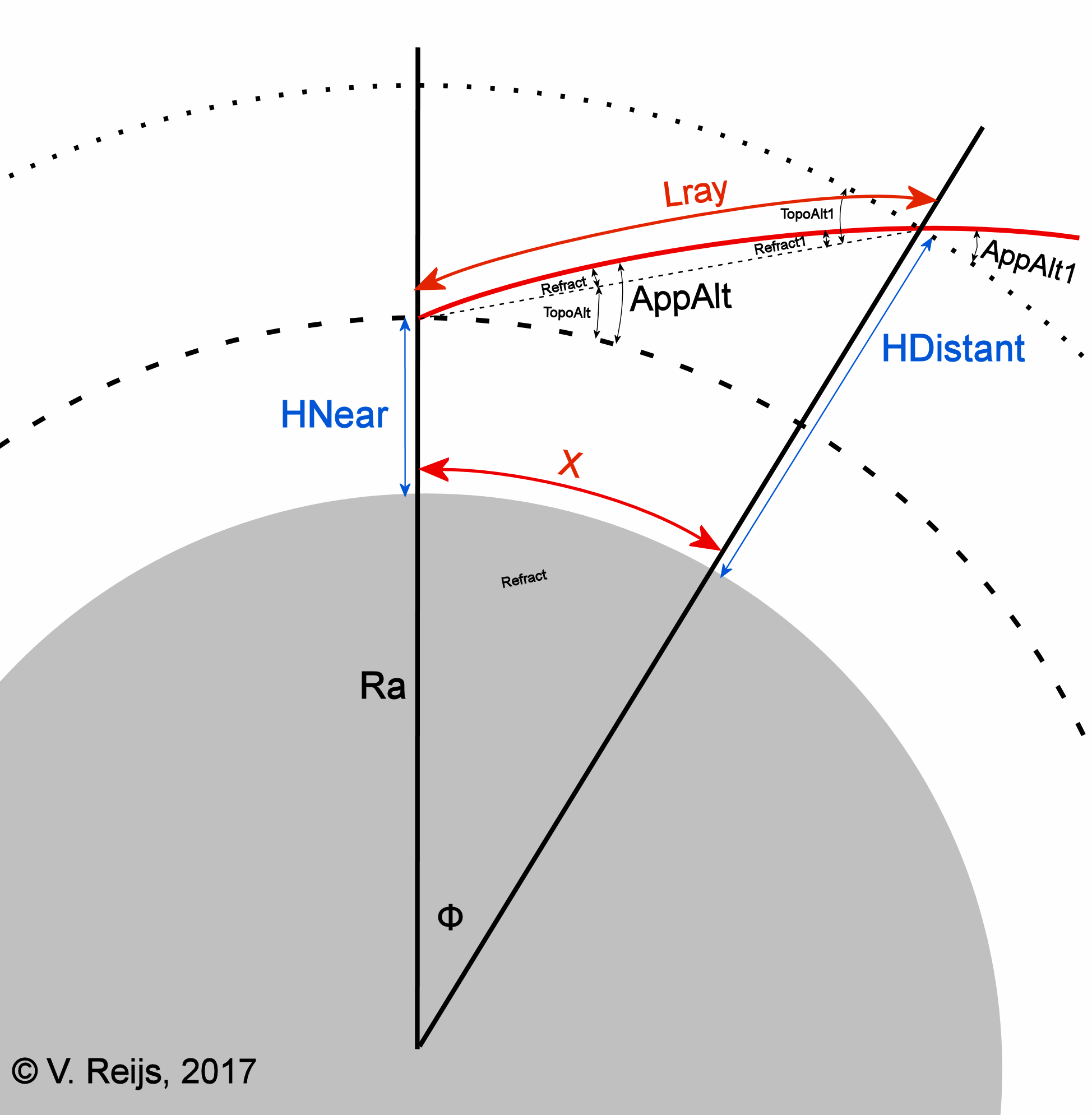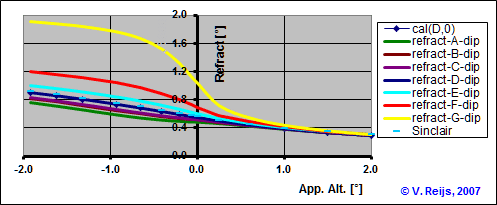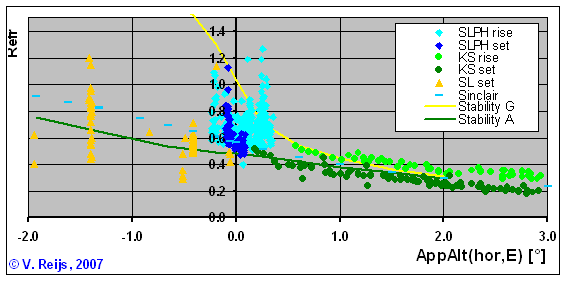 Home
Home Up
Up Search
Search Mail
Mail
NEW
Refraction
Refraction is the bending of light through the atmosphere. Three
types are normally recognised in literature from astronomy,
navigation and geodesy environments:
- Astronomical refraction
The refraction is determined for a light path from the eyes'
position to the end of the Earth's atmosphere (in direction of a
celestial object).
- Levelling refraction
The refraction is determined for a light path that has a
large part level with the Earth's geoid, aka a vast level
surface below the eyes' position is involved. Also known as dip.
- Terrestrial
refraction
The refraction is determined for a light path that goes from
the eyes' position to a terrestrial object higher or lower than
the eyes' position.
Astronomical refraction is 'coupled'
in a great deal with terrestrial
refraction. A celestial objects is during many times
observed over a terrestrial object, and thus both the terrestrial
object and the celestial object are refracted and have a common
light path, and that light path can be close to the ground;
certainly in case of a vast level surface (levelling refraction).
Even if a celestial object is not observed over a terrestrial
object the light still travel through the atmosphere.

The largest influence of refraction is due to high temperature
gradients, and these are normally the largest near the ground
surface. As the light path is the longest when the light travels
over a vast level surface, that situation produces the largest
(variation of) refraction.
Astronomical refraction
The astronomical refraction is in many cases expressed as a function
from the topocentric altitude of a celestial body.
From an old book (De sterren hemel, Kaiser, F., 1845) one can get
information about the astronomical refraction. The conditions for
this table are:
- it is calculated over a (vast level) surface with a
temperature of melting ice.
Doing some calculations with SkyMap; an increase of 5o
C, decreased the apparent altitude with 1'. Thus the astronomical
refraction increased with some 5%.
- at normal air pressure.
Astronomical refraction
| Apparent altitude |
Astronomical
refraction |
| o |
' |
| -0.5 |
40 |
| 0 |
35 |
| 0.16 |
33 |
| 0.32 |
31 |
| 0.5 |
29 |
| 0.66 |
28 |
| 0.83 |
26 |
| 1 |
24 |
| 2 |
18 |
| 3 |
14 |
| 5 |
10 |
| 10 |
5 |
| 20 |
2.5 |
| 30 |
1.5 |
| 50 |
.5 |
| 90 |
0 |
Or using the Sinclair (Bennett ([1982, page 257], formula B) at 10°C
and 1010mbar:
AstroRefractATS = (34.46 + 4.23*AppAlt + 0.004*AppAlt2) / (1 + 0.505*AppAlt + 0.0845*AppAlt2)/60
TopoAlt = AppAlt - Refract
The inverse astronomical refraction function (with a sigma of 0.03o)
has been determined using SIMPLEX optimisation algorithm (by Victor
Reijs):
InvRefract = (34.73 - 0.7711*TopoAlt - 0.0004693*TopoAlt2) / (1.119 + 0.2979*TopoAlt + 0.0316*TopoAlt2)/60
AppAlt = TopoAlt + InvRefract
With:
- AstroRefract: astronomical refraction [o]
- InvRefrac: 'inverse astronomical refraction' [o]
- AppAlt.: apparent altitude [o] of a celestial body,
> -3.5o
- TopoAlt: topocentric altitude [o] of a celestial
body, > -4.5o
For more theoretical information on astronomical refraction see: Astronomical refraction and this article.
Refraction of a terrestrial object
Two case will be presented here:
Levelling refraction due to vast level surface
The angular depression of the apparent horizon is called levelling
refraction (also known as (apparent) dip). According to Thom, A., 1973 (page 32, and changing it
to metric and making air pressure and temperature explicit) the
refraction due to a vast level surface is:
LevelRefractVR = ACOS(1 / (1 + Elev
/ Ra)) -ACOS(1 / (1 + Elev / Ra*(1-1.8480*K*P/(273.15+T)^2)))
<most
likely the P/T^2 part is outside the ACOS>
With:
- LevelRefract: levelling refraction [o]
- Elev: elevation difference in [m] between observer's eyes (Near Height) and vast plane
(Height Distant) (Near Height -
Distant Height). Both Near and Distant
Height must have same reference.
- K: refraction constant
K=4.91 at noon, K=10.64 during sun set/rise and night (equinox,
wind speed [4 m/sec] (at 10 m height) and latitude 53°)
- P: air pressure at Near
Height [mbar]
- T: temperature at Near
Height [°C]
- Ra: radius of earth = 6378137 [m]
Remember that the above does not include atmospheric conditions like
extraordinary convective and inversions boundary layers. For more
theoretical information on horizon dip see: Dip of the Horizon.
Terrestrial refraction
The terrestrial refraction changes the apparent altitude of a
terrestrial body.
If one needs to calculate the terrestrial refraction, seen from
local point, of a distant object (like the top of a mountain), the
following formula is needed (from Thom,
A., 1973, page 31 and changing it to metric and keeping air
pressure explicit):
TerrestRefractVR = 0.00830*K*Lray*P/(273.15+T)^2
With:
- TerrestRefract: terrestrial refraction [o]
- Elev: elevation difference [m] between point Near Height and Distant Height (Distant Height - Near Height). Both Near and
Distant Height must have same reference/datum.
- X: distance [km] between Near
and Distant object
(measured along earth's geoid)
- Lray: distance [km] between Near and Distant
object (measured along the light ray)
- K: refraction
constant K=4.91 at noon, K=10.64 during sun set/rise and
night (equinox, wind speed [4 m/sec] (at 10 m height) and
latitude 53°)
The derivation of K's dependency on the lapse rate:
K = 990/2* (1/R + g) (formula (5) in Thom, 1985: with l=L and
near horizontal ray path)
R =53.3 ft
g =F/ft (temp. gradient)
γ =C/m (temp. gradient)
K = 495 * (1*0.304/53.3 + (9/5)*0.304*γ)
K = 495*0.304 * (1/53.3 + (9/5)*γ)
K = 15058*9/5 * (1/53.3*(5/9) + gamma)
K = 270.9 * (0.0337 + γ) (the 0.0337 should be 0.034177:
according to van der Werf, 2003, page 362)
K = 41.7 * (0.0342 + γ)/0.154
K = 41.7 * k
K = k/0.0240
- P: air pressure at Eye
elevation [mbar]
- T: temperature at Eye
elevation [°C]
Remember that the above does not include atmospheric conditions like
extraordinary convective and inversions boundary layers. For more
theoretical information on terrestrial refraction see: Astronomical refraction.
Ray tracing refraction
Using the computation
method of HOSI (Hohenkerk&Sinclair, [1985]), which traces the rays by
integration along the apparent altitude under the circumstances T0=15
[C], P0=1013.25 [mbar], RH(0)=0%, latitude observer = 50o,
remote vast level surface elevation see below
(equivalent with windspeed 7.5 [m/sec]), a lapse rate at 0 [m] level
compatible with the stability class,
a type of surface layer Hc=1000 [m] (van der
Werf, [2003], formula (52)) and MUSA76
atmosphere (van der Werf, [2003], Table
1). This method handles the astronomical, levelling and
terrestrial refraction in an integral way.
The following astronomical refraction is seen
due to the apparent altitude:

- In practice, the stability class will vary for
Sun set/rise events mostly between D (dark blue line) to F (red
line) and with lower frequency A (green) and G (yellow) can
happen (C and B happen even with a lower frequency).
- It is important to realise that in
the above calculations, the Near Height (at the
observer) has been adjust to make sure that the light
path passes over the (vast level)
surface. So for negative altitudes the light path is
normally (but does not have to be the case! Depending
on the relative elevation of observer and surface/object) over a
vast level surface, for positive ones it is not coming that
close to the ground and thus the temperature gradients
variations are also smaller.
- For the lines that have 'dip' at
the end (purple [C], dark blue [D], light blue [E], red [F] and
yellow [G] lines), the elevation of the observer (HObs)
is changed to make sure that the AppAl. is equivalent to the dip
(HObs between 4200 and 5 [m]). For apparent altitudes
bigger then 0o, the observer height was kept constant
at 5 [m] above ground.
These cases would be close to actual astronomical refraction measurements as
done above. The interesting is that the limiting
of astronomical refraction has a somewhat comparable
behavior as in the measurements.
- The variation in astronomical
refraction might be constant for positive apparent altitudes
(PAAR) ; 'large'
meaning AppAlt>0.25o
- The astronomical refraction formula of Sinclair
is very close to the stability class D (dark blue) line (which
uses the standard atmosphere line).
- No change in Hc has been included yet. This could
perhaps help in explaining the change of astronomical refraction
during Sun set and rise events (the Hc is somewhat
related to the atmospheric boundary layer). Although the
behavior seen in Seidelmann's measurements looks not explainable
using a surface layer. See here for an evaluation on surface
layer.
- More study is needed with regard to the boundary layer.
- It might be good to also implement the computation method of
van der Werf (2003). That is a slightly different method than
Hohenkerk&Sinclair and Sinclair's refraction formula, as it
uses integration along the geoid distance (instead of along the
apparent altitude). Van der Werf allows non-spherical
height-temperature profiles.
- One can distinguish three apparent
altitude regions (PAAR, AZAAR and NAAR) that are resulting
due to variability of the temperature gradient of observation
for a vast level surface.
- Also the variation of the refraction does not change that much
with changing negative apparent altitudes (NAAR) while the
temperature gradient is constant. This looks to be due to the
fact that the length of the light path close the vast level
surfaces is some what independent of the value of this
(negative) angle.
Refraction measurements
The following picture is based on refraction measurements by
Schaefer&Liller (SL) [1990],
Seidelmann
(KS) (1968 as quoted in Schaefer&Liller [1990],
page
800-801), Sampson (SLPH) [2003]
and the Sinclair formula. All of these used astronomical
observations that involved a vast level surface.
The calculated curves are: Sinclair is using USA76 atmospheric model
and Stability A and G use the MUSA76 atmospheric model (all
calculated values are based on: 1.5m eye elevation, 15C, 1013.25mbar
and 0%).
One can see an overall large standard deviation (1 sigma: ~0.15o)
in actual live and the slight difference between sun rise and set
events (~0.1o).
It is not very clear if the standard deviation will increase with
lower apparent altitudes (although that is expected). For instance
the standard deviation for observations around -0.4o is
0.05o (n=75) has a smaller standard deviation then
observations at 0o with 0.15o (n=260), and at
-1.3o the standard deviation is higher (twice as high as
at 0o being 0.3o (n=25). The variation (between min. and max.) looks to be
the same for observation at apparent altitude of -1.3o
and 0o: around 0.8o degrees. Looks to be some
limiting going on. Looking
at the below calculations the
deviation might indeed stay more or less the same for negative
apparent altitudes. The possible
calculated limiting
stability classes A and G are given.
Not enough data points are available to see if there is a
significant difference, the below calculations
might give some insight.
Calculating the effects of refraction on apparent altitude
Browser should support JavaScript (see here for description of these
functions)


